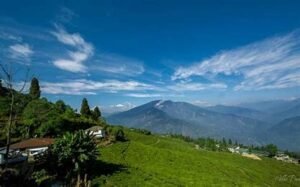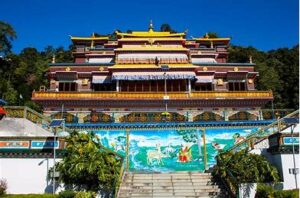Majuli is the world’s largest river island. Often described as the soul of Assam, it is the heart of the northeastern Indian state. It floats like a serene, vibrant jewel amidst the wild waters of the Brahmaputra River. With an area of 421 square kilometers, Majuli holds the prestigious title of the largest river island on Earth. But its significance is not merely geographical—Majuli is a cultural and spiritual hub, a place steeped in history and tradition. It is a sacred space where the past and present coexist harmoniously.
From its role as the cradle of Assamese neo-Vaishnavite culture to its rich biodiversity and vibrant tribal communities, Majuli offers a unique blend of natural beauty and human heritage. In this blog, we will explore the fascinating history, culture, traditions, and modern-day relevance of Majuli Island, alongside its role as the epicenters of Assamese spirituality.
Majuli: A Cultural Capital of Assam
Majuli is often hailed as the cultural capital of Assam. Its legacy as the birthplace and the heart of Assamese neo-Vaishnavite culture, initiated by the great saint-reformer Srimanta Sankardeva in the 15th century. This makes it an extraordinary place in the cultural landscape of India. Sankardeva is often regarded as the architect of Assamese culture. He introduced the Bhakti movement and laid the foundation for neo-Vaishnavism. It is a devotional form of Hinduism centered around Lord Krishna.
Srimanta Sankardeva’s teachings gave rise to a unique form of cultural expression that combined religious worship, music, dance, drama, and literature. This continues to thrive in Majuli through its numerous satras (monasteries). These satras are not just religious centres; they are also vibrant hubs of artistic and intellectual activities. They preserve the essence of Sattriya dance, an ancient classical dance form, along with the tradition of bhaona (theatrical performances), music, mask-making, and even pottery-making. The Satras of Majuli are a testament to the island’s rich cultural heritage and a reminder of the continuing influence of Sankardeva’s vision.
The Satras: Pillars of Spiritual and Cultural Life
At the heart of Majuli’s spiritual and cultural identity are its 22 satras, each acting as a self-contained institution for both religious practice and artistic expression. The Satras, dating back to the 16th century, are centers of Assamese Vaishnavism. The word ‘satra’ comes from the Sanskrit term ‘sattri,’ which means a place for devotional service, a retreat dedicated to Lord Vishnu. The Satras have played a critical role in preserving the traditions of Sattriya dance, music, and literature, which were all integral to the spiritual practices of the neo-Vaishnavite movement.
Each sathra is led by a Satradhikar, a learned scholar, playwright, actor, and social reformer who presides over the cultural and spiritual activities of the community. Through their performances, teaching, and leadership, the Satradhikars have kept alive the age-old traditions of Majuli, ensuring that they continue to thrive. Visitors to Majuli often have the opportunity to witness these performances, including the mesmerising dance forms, and engage with the cultural richness that the island embodies.
Majuli’s Mask-Making Tradition
One of the most unique and well-known cultural crafts of Majuli is its mask-making tradition. Majuli is renowned for producing intricately crafted masks used in the traditional bhaona (theatre) performances held in the Satras. These masks are not just artistic creations; they are deeply symbolic, representing gods, goddesses, demons, animals, and other figures from Assamese mythology. The mask-making tradition on the island dates back centuries and remains an integral part of the island’s cultural identity.
The craftsmanship involved in creating these masks is exceptional, with artisans using natural materials such as bamboo, clay, and papier-mâché to create large, expressive faces that evoke deep cultural and spiritual significance. These masks are used during religious festivals and cultural performances, often worn by dancers as they bring stories from Hindu epics and folklore to life. Visiting the workshops where these masks are made is a must for anyone seeking to understand the artistic legacy of Majuli.
Majuli’s Diverse Tribes and Communities
Majuli is not only a cultural and spiritual hub, but it is also home to a rich diversity of tribes and communities. The island is primarily inhabited by three tribes—Mishing, Deori, and Sonowal Kachari—along with a significant number of non-tribal Assamese people. These indigenous communities have their own distinct traditions, customs, and ways of life that contribute to the cultural mosaic of Majuli.
The Mishing people, the largest tribe on the island, have a long history of agriculture, fishing, and handloom weaving. Their traditional homes, built on stilts to protect them from the seasonal floods, dot the landscape of Majuli. The Deori and Sonowal Kachari tribes also contribute to the island’s cultural richness, with their own language, dance forms, and rituals that are distinct to their heritage. Visitors to Majuli can engage with these communities, learning about their unique cultures and traditions, which have been passed down through generations.
Majuli’s Biodiversity and Ecological Importance
Beyond its cultural and spiritual significance, Majuli is also a critical ecological hotspot. The island is surrounded by the mighty Brahmaputra River, which brings with it the annual floods and erosion that shape the island’s landscape. The unique geographical setting of Majuli, combined with its rich biodiversity, makes it a haven for nature lovers and bird watchers.
Majuli is home to a wide range of flora and fauna, including numerous migratory birds that flock to the island during the winter months. The island’s wetlands and lush greenery support a diverse ecosystem, providing a safe habitat for exotic species of birds, including the endangered Greater Adjutant Stork, which nests in the region. The island’s biodiversity is an essential part of its charm, offering visitors a rare opportunity to experience a thriving ecosystem in the midst of cultural and spiritual activities.
Challenges Faced by Majuli
Despite its rich cultural heritage and natural beauty, Majuli is not without its challenges. The island is constantly battling the forces of erosion and the effects of annual flooding caused by the Brahmaputra River. Over the years, the island has lost significant portions of land, and these changes threaten both the local communities and the preservation of its cultural landmarks.
In response to these challenges, the government and local organizations have undertaken various efforts to protect the island’s ecology, including measures to combat soil erosion and preserve its biodiversity. However, the fight against these natural forces continues, making it crucial for both locals and visitors to be aware of the island’s environmental significance and the importance of conservation efforts.
Conclusion
Majuli is more than just a geographical location. It is a living, breathing canvas of Assamese culture, spirituality, and history. As the world’s largest river island, Majuli remains an oasis of traditional arts, literature, and religious practices. This has shaped the Assamese identity for centuries, Majuli’s shores is a promise an unforgettable culture and heritage. This island is not just a journey across a river island—it’s a journey into the heart and soul of Assam itself.




